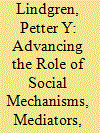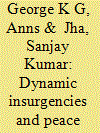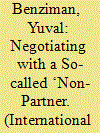|
|
|
Sort Order |
|
|
|
Items / Page
|
|
|
|
|
|
|
| Srl | Item |
| 1 |
ID:
169252


|
|
|
|
|
| Summary/Abstract |
In this article, I further develop the Copenhagen School’s securitization theory in a causal direction, by emphasizing the explanatory family of mechanisms, mediators and moderators. In the first half of this article, I present two models for conceptualizing the causal maps that securitization is part of. Next, I define five epistemological and methodological dimensions that are important for modelling securitization with causal power. The proposed approach is then put into practice by two most-similar case studies in the second half of the article: securitization attempts in Japan in 2006-07 and in 2012-15. By comparing his securitization efforts in 2006 and in 2012-15 respectively, I identify why PM Abe was successful in his securitization attempt in the latter period. Furthermore, I propose an explanatory set that together with securitization enabled certain effects to take place in Japan, namely the introduction of collective self-defense in 2014/15.
|
|
|
|
|
|
|
|
|
|
|
|
|
|
|
|
| 2 |
ID:
084349


|
|
|
|
|
| Publication |
2008.
|
| Summary/Abstract |
Third-party actors who mediate or monitor peace often strive to uphold an image of neutrality. Yet, they commonly face accusations of partiality. The Nordic engagement in the Sri Lankan peace process is an illustration of this puzzle: despite the efforts to uphold an image of being neutral mediators and monitors, they have been seen as favoring one side or the other. This article suggests that part of the explanation for their failure to be seen as neutral lies in the fact that armed conflicts are characterized by certain asymmetries between the main antagonists - in capabilities, status and behavior. These imbalances pose particular challenges to the third party aspiring to act in a neutral manner. We suggest that third parties have two strategies available to deal with imbalances in the relationship between the contenders: 1) they can choose to disregard the asymmetrical relationship and act in an even-handed manner or 2) they can seek to counterbalance the lopsidedness. This article explores the dynamics of these strategies by analyzing the Nordic involvement in Sri Lanka's peace process that began in 2002.
|
|
|
|
|
|
|
|
|
|
|
|
|
|
|
|
| 3 |
ID:
188326


|
|
|
|
|
| Summary/Abstract |
The intended purpose of this paper is to examine the viability of political resolution as a counterinsurgency strategy. We have selected numerous political negotiation processes between insurgents and government of India in general and Mizoram in particular. The political resolution with Mizo National Front is considered as the most successful counterinsurgency operation in India. Placing this as a model, the government of India employed the strategy of negotiation with various other insurgent groups. The degree of success in Mizoram was not replicated in other insurgency theatres. This was analyzed with the help of a comparative study with other insurgent groups in India, particularly within the state of Assam. It is found that the model of Mizo resolution has been influencing the peace process that came later. And also the strategy of negotiation has been evolving into incorporating civil society groups as signatories to the final peace settlement signed between insurgents and government. This analysis of the peace process is also based on the conceptualization developed from various authors.
|
|
|
|
|
|
|
|
|
|
|
|
|
|
|
|
| 4 |
ID:
087570


|
|
|
|
|
| Publication |
2009.
|
| Summary/Abstract |
Increasingly, scholars have taken note of the tendency for women to conceptualize issues such as security, peace, war, and the use of military force in different ways than their male counterparts. These divergent conceptualizations in turn affect the way women interact with the world around them and make decisions. Moreover, research across a variety of fields suggests that providing women a greater voice in international negotiations may bring a fresh outlook to dispute resolution. Using experimental data collected by the GlobalEd Project, this article provides substantial support for hypotheses positing that females generate significantly different processes and outcomes in a negotiation context. These findings occur both in terms of female negotiation behavior and the impact of females as negotiation facilitators/mediators.
|
|
|
|
|
|
|
|
|
|
|
|
|
|
|
|
| 5 |
ID:
180893


|
|
|
|
|
| Summary/Abstract |
There are conflicts in which the opposing sides perceive and define their adversary as a “non-partner” with whom they are unable or unwilling to negotiate. However, notwithstanding this reciprocal mistrust, negotiate they do. This research fills a theoretical gap in the study of negotiations by mapping five distinct practices of negotiations with a so-called non-partner: firstly, negotiate while claiming that no negotiations are taking place; secondly, use third parties as mediators or what I term “mediators+”; thirdly, negotiate agreements “over the head” of the so-called non-partner; fourthly, act unilaterally; and fifthly, negotiate relatively minor issues. Two alternative negotiation practices are also discussed: one is to negotiate agreements in non-related conflicts that may eventually influence the conflict actually on the table, and the other is to negotiate within the ingroup on the nature of negotiations should they take place. This study uses the Israeli-Palestinian conflict as a test case.
|
|
|
|
|
|
|
|
|
|
|
|
|
|
|
|
|
|
|
|
|